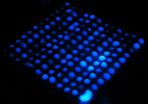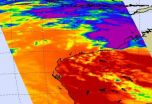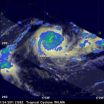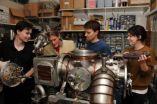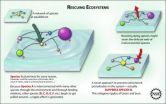(Press-News.org) WEST LAFAYETTE, Ind. - Researchers have invented a technique that uses inexpensive paper to make "microfluidic" devices for rapid medical diagnostics and chemical analysis.
The innovation represents a way to enhance commercially available diagnostic devices that use paper-strip assays like those that test for diabetes and pregnancy.
"With current systems that use paper test strips you can measure things like pH or blood sugar, but you can't perform more complex chemical assays," said Babak Ziaie, a Purdue University professor of electrical and computer engineering and biomedical engineering. "This new approach offers the potential to extend the inexpensive paper-based systems so that they are able to do more complicated multiple analyses on the same piece of paper. It's a generic platform that can be used for a variety of applications.╙
Findings are detailed in a research paper published online this week in the journal Lab on a Chip.
Current lab-on-a-chip technology is relatively expensive because chips must be specifically designed to perform certain types of chemical analyses, with channels created in glass or plastic and tiny pumps and valves directing the flow of fluids for testing.
The chips are being used for various applications in medicine and research, measuring specific types of cells and molecules in a patient's blood, monitoring microorganisms in the environment and in foods, and separating biological molecules for laboratory analyses. But the chips, which are roughly palm-size or smaller, are difficult to design and manufacture.
The new technique is simpler because the testing platform will be contained on a disposable paper strip containing patterns created by a laser. The researchers start with paper having a hydrophobic - or water-repellant - coating, such as parchment paper or wax paper used for cooking.
"We can buy this paper at any large discount retail store," Ziaie said. "These patterns can be churned out in the millions at very low cost."
A laser is used to burn off the hydrophobic coatings in lines, dots and patterns, exposing the underlying water-absorbing paper only where the patterns are formed.
"Since the hydrophobic agent is already present throughout the thickness of the paper, our method creates islands of hydrophilic patterns," Ziaie said. "This modified surface has a highly porous structure, which helps to trap and localize chemical and biological aqueous reagents for analysis. Furthermore, we've selectively deposited silica microparticles on patterned areas to allow diffusion from one end of a channel to the other."
Those microparticles help to wick liquid to a location where it would combine with another chemical, called a reactant, causing it to change colors and indicating a positive or negative test result.
Having a patterned hydrophilic surface is needed for many detection methods in biochemistry, such as enzyme-linked immunosorbent assay, or ELISA, used in immunology to detect the presence of an antibody or an antigen in a sample, Ziaie said.
To demonstrate the new concept, the researchers created paper strips containing arrays of dots dipped in luminol, a chemical that turns fluorescent blue when exposed to blood.
"Then we sprayed blood on the strips, showing the presence of hemoglobin," said Ziaie, whose research is based at the Birck Nanotechnology Center in the university's Discovery Park. "This is just a proof of concept."
Laser modification is known to alter the "wettability" of materials by causing structural and chemical changes to surfaces. However, this treatment has never before been done on paper, he said.
The researchers performed high-resolution imaging and spectroscopic analysis to study the mechanism behind the hydrophobic-hydrophilic conversion of laser-treated parchment paper.
The new approach is within a research area called paper microfluidics.
"Other techniques in paper microfluidics are more complicated," Ziaie said.
For example, other researchers have developed a method that lays down lines of wax or other hydrophobic material on top of untreated, hydrophilic paper.
"Our process is much easier because we just use a laser to create patterns on paper you can purchase commercially and it is already impregnated with hydrophobic material," Ziaie said. "It's a one-step process that could be used to manufacture an inexpensive diagnostic tool for the developing world where people can't afford more expensive analytical technologies."
The strips might be treated with chemicals that cause color changes when exposed to a liquid sample, with different portions of the pattern revealing specific details about the content of the sample. One strip could be used to conduct dozens of tests, he said.
The strips might be inserted into an electronic reader, similar to technology used in conventional glucose testers. Color changes would indicate the presence or absence of specific chemical compounds.
INFORMATION:
The research paper was written by graduate students Girish Chitnis, Zhenwen Ding and Chun-Li Chang; Cagri A. Savran, an associate professor of mechanical engineering, biomedical engineering and electrical and computer engineering; and Ziaie.
The National Science Foundation funded the work.
The researchers have patented the technique and it is available for licensing through Joseph Trebley, senior project manager for the Purdue Research Foundation Office of Technology Commercialization, at 765-588-3832, jptrebley@prf.org (http://www.prf.org/otc).
Writer: Emil Venere, 765-494-4709, venere@purdue.edu
Source: Babak Ziaie, 765-494-0725, bziaie@purdue.edu
Related website:
Babak Ziaie: https://engineering.purdue.edu/ECE/People/profile?resource_id=2839
PHOTO CAPTION:
Researchers have invented a technique that uses inexpensive paper to make "microfluidic" devices for rapid medical diagnostics and chemical analysis. To demonstrate the new concept, the researchers created paper strips containing arrays of dots dipped in luminol, a chemical that turns fluorescent blue when exposed to blood. Blood was then sprayed on the strips, showing the presence of hemoglobin. (Birck Nanotechnology Center, Purdue University)
A publication-quality photo is available at http://www.purdue.edu/uns/images/2011/ziaie-paper.jpg
PHOTO CAPTION:
Colored water is used to show how liquid wicks along tiny channels formed in paper using a laser, in research to develop a new technology for medical diagnostics and chemical analysis. Silica microparticles were deposited on patterned areas, allowing liquid to diffuse from one end of a channel to the other. (Birck Nanotechnology Center, Purdue University)
A publication-quality photo is available at http://www.purdue.edu/uns/images/2011/ziaie-paper02.jpg
Abstract on the research in this release is available at: http://www.purdue.edu/newsroom/research/2011/110125ZiaiePaper.html
New lab-on-chip advance uses low-cost, disposable paper strips
2011-01-26
ELSE PRESS RELEASES FROM THIS DATE:
Armchair nanoribbons made into spintronic device
2011-01-26
Washington, D.C. (January 25, 2011) -- In a development that may revolutionize handheld electronics, flat-panel displays, touch panels, electronic ink, and solar cells, as well as drastically reduce their manufacturing costs, physicists in Iran have created a spintronic device based on "armchair" graphene nanoribbons. Spintronic devices are being pursued by the semiconductor and electronics industries because they promise to be smaller, more versatile, and much faster than today's electronics.
As described in the American Institute of Physics journal Applied Physics Letters, ...
Nanotech milling produces dramatic increase in thermoelectric performance of bulk semiconductor
2011-01-26
CHESTNUT HILL, MA (1/25/11) -- Researchers from Boston College, MIT, Clemson and Virginia have used nanotechnology to achieve a 60-90 percent increase in the thermoelectric figure of merit of p-type half-Heusler, a common bulk semiconductor compound, the team reported in the American Chemical Society journal Nano Letters.
The dramatic increase in the figure of merit, used to measure a material's relative thermoelectric performance, could pave the way for a new generation of products – from car exhaust systems and power plants to solar power technology – that that runs ...
Graphene and 'spintronics' combo looks promising
2011-01-26
Washington, D.C. (January 25, 2011) -- A team of physicists has taken a big step toward the development of useful graphene spintronic devices. The physicists, from the City University of Hong Kong and the University of Science and Technology of China, present their findings in the American Institute of Physics' Applied Physics Letters.
Graphene, a two-dimensional crystalline form of carbon, is being touted as a sort of "Holy Grail" of materials. It boasts properties such as a breaking strength 200 times greater than steel and, of great interest to the semiconductor and ...
NASA infrared data sees birth of 10th tropical depression in Southern Indian Ocean near Australian coast
2011-01-26
NASA's Aqua satellite captured an infrared image of the very cold clouds that house powerful thunderstorms within the Southern Indian Ocean's newest tropical depression, number 10S. The depression quickly strengthened into a tropical storm and continues to affect the northern coast of Western Australia.
When Aqua passed over the Tropical Storm 10S on January 25 at 05:53 UTC (12:53 a.m. EST), the Atmospheric Infrared Sounder (AIRS) instrument captured an infrared image of the storm's clouds. The image showed that most of the coldest cloud tops (-63 Fahrenheit/-52 Celsius) ...
February 2011 Geology and GSA Today highlights
2011-01-26
Boulder, CO, USA – The February issue of Geology is online now. Articles cover Patagonian glaciations, the Younger Dryas cold period, paleodiversity, submarine gullies, the Transantarctic Mountain micrometeorite collection, the "fastest glacier on Earth," salt diapirs in the Nordkapp Basin, reinterpretation of James Hutton's historic discovery on the Isle of Arran, a new tool to directly date dinosaur-bone fossils, ancient megalakes in Australia, Egypt's Kamil Crater, and more. GSA TODAY examines seismic activity to gain insights into the Rio Grande Rift.
Keywords: Ammonoids, ...
Cyclone Wilma's eye catches attention of NASA satellites
2011-01-26
Wilma caught the eye of NASA. NASA's Aqua satellite captured visible and infrared images of Cyclone Wilma in the Southwestern Pacific Ocean and her eye was clearly visible from space.
On January 25 at 00:59 UTC (8:59 p.m. EST on Jan. 24), the Atmospheric Infrared Sounder (AIRS) instrument captured data that was used to create infrared and visible images at NASA's Jet Propulsion Laboratory in Pasadena, Calif. The images showed Cyclone Wilma had strengthened overnight and now has a visible eye.
AIRS Infrared imagery showed strong, very cold thunderstorm cloud tops around ...
Hot flushes are linked with a significant reduction in breast cancer risk
2011-01-26
SEATTLE – Women who have experienced hot flushes and other symptoms of menopause may have a 50 percent lower risk of developing the most common forms of breast cancer than postmenopausal women who have never had such symptoms, according to a recent study by researchers at Fred Hutchinson Cancer Research Center.
The results of the first study to examine the relationship between menopausal symptoms and breast cancer risk are available online ahead of the February print issue of Cancer Epidemiology Biomarkers and Prevention.
The protective effect appeared to increase along ...
Evolution by mistake
2011-01-26
Charles Darwin based his groundbreaking theory of natural selection on the realization that genetic variation among organisms is the key to evolution.
Some individuals are better adapted to a given environment than others, making them more likely to survive and pass on their genes to future generations. But exactly how nature creates variation in the first place still poses somewhat of a puzzle to evolutionary biologists.
Now, Joanna Masel, associate professor in the UA's department of ecology and evolutionary biology, and postdoctoral fellow Etienne Rajon discovered ...
Physicists take new look at the atom
2011-01-26
Measuring the attractive forces between atoms and surfaces with unprecedented precision, University of Arizona physicists have produced data that could refine our understanding of the structure of atoms and improve nanotechnology. The discovery has been published in the journal Physical Review Letters.
Van der Waals forces are fundamental for chemistry, biology and physics. However, they are among the weakest known chemical interactions, so they are notoriously hard to study. This force is so weak that it is hard to notice in everyday life. But delve into the world of ...
Mathematical model could help predict and prevent future extinctions
2011-01-26
In an effort to better understand the dynamics of complex networks, scientists have developed a mathematical model to describe interactions within ecological food webs. This research, performed by Northwestern University physics professor Adilson Motter and his student, Sagar Sahasrabudhe, is published in the January 25 issue of Nature Communications. The work illustrates how human intervention may effectively aid species conservation efforts.
"Our study provides a theoretical basis for management efforts that would aim to mitigate extinction cascades in food web networks. ...
